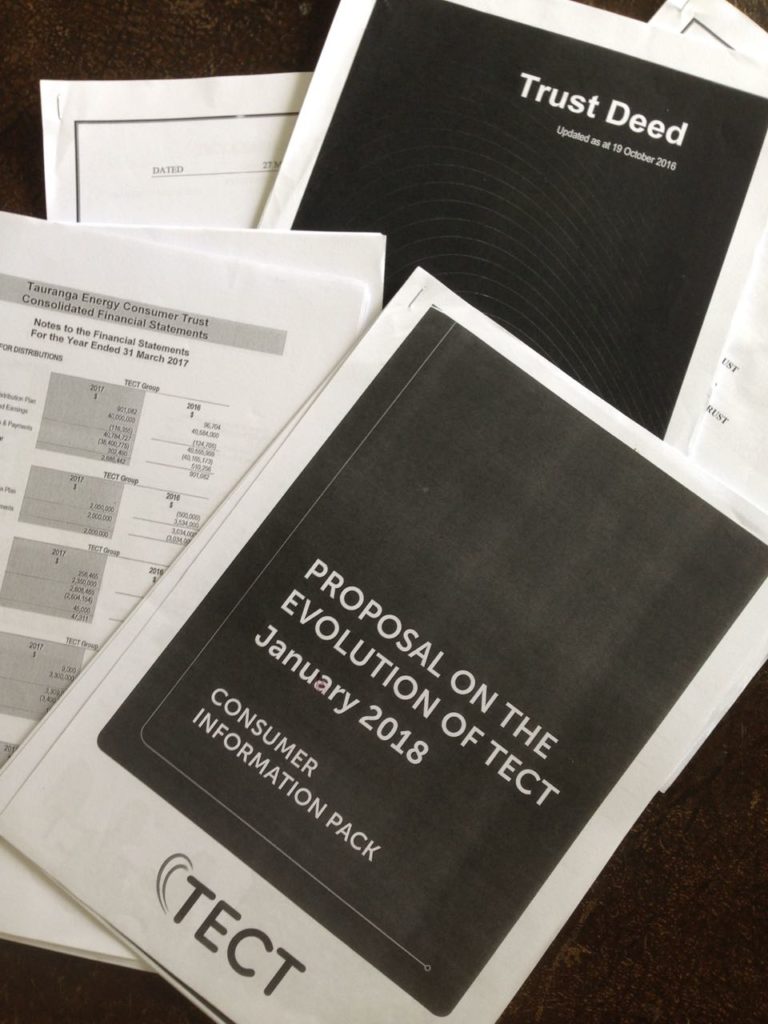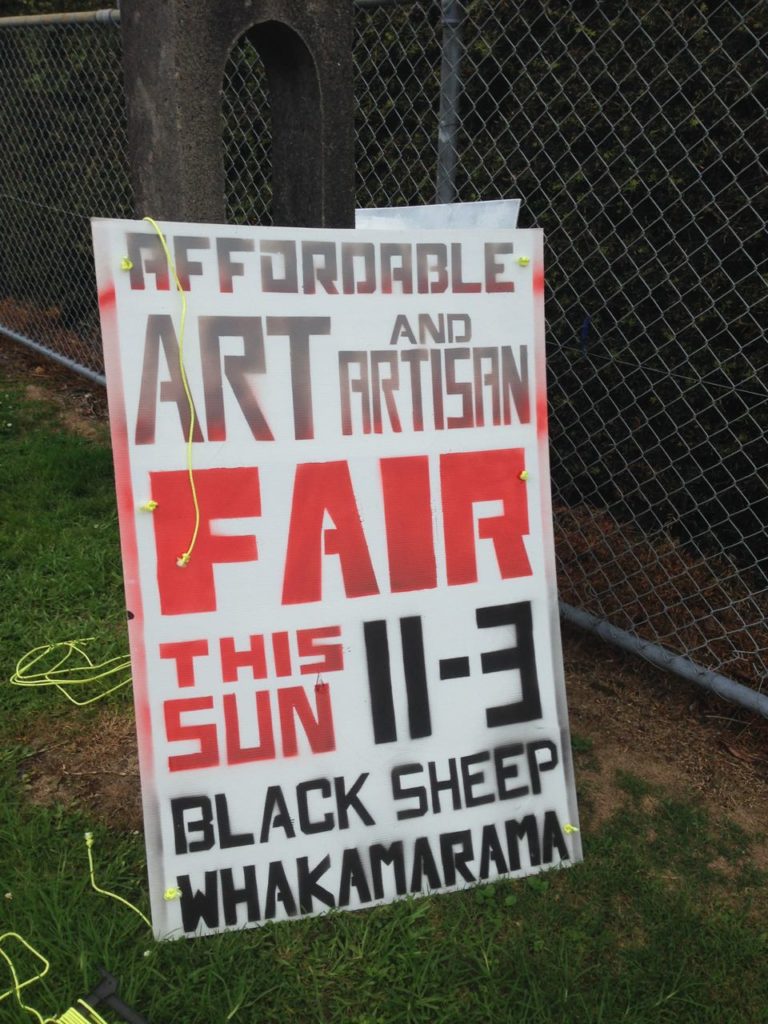The fundamental issues are:
1. Should the primary purpose of the Tauranga Energy Consumer Trust be changed from a consumer trust to a solely charitable trust.
2 Should one category of beneficiary of the Tauranga Energy Consumer Trust be eradicated to achieve that purpose.
3. If so, what is a fair and reasonable basis on which to compensate the category of consumer to be eradicated for the loss of it’s share in the assets of the trust.
4. And if the Trust becomes merely a charitable trust, should the definition of “Charitable Body” be expanded as indicated in the proposed updated draft (TECT Charitable Trust updated 2018) to include any “person, entity, club”…..”partnership”……”(whether its sole purpose or not”) that is a mix of private pecuniary profit and “charitable purpose”.
“TECT is not a charitable Trust and accordingly may not continue for more than 80 years. On the winding up of the Trust the assets of the Trust, which remain, will be distributed for the benefit of Consumers;” … say the notes to the Summarised Consolidated Financial Statements for the year ended 31 March 2017 ticked off by KPMG (Tauranga) the TECT Group Auditors.
The assets of the Tauranga Energy Trust are currently estimated to be about $760million having diminished since the 2017 accounts were published.
The notes also say” “The Tauranga Energy Consumer Trust was established under a Trust Deed on 21 December 1993 as a consequence of the Tauranga Electric Power Board’s Establishment Plan. TECT is a consumer trust the income and capital of which are to be used to provide benefits to Consumers who are Trustpower customers in the area defined in the Trust Deed (being the area supplied by the Tauranga Electric Power Board as at 21 December 1993 subsquently amended to include the Tauranga district area previously supplied by Tauranga Electricity Limited.”
In 1993 the assets of the Tauranga Energy Consumer Trust were the registered public company created from the assets of the Tauranga Electric Power Board.
(Power Board customers at the time were also entitled to a small parcel of shares in the newly formed company. Those individually owned shares give their owners a dividend like any other privately owned shareholding and are nothing to do with TECT).
So the original and fundamental purpose of the Tauranga Energy Consumer Trust was to benefit those individuals who became customers of Trustpower as an electricity supplier – profit for the people. 
In 2002 a new trust, a charitable trust was added: The TECT Charitable Trust. I haven’t had access to copies of the revised/changed versions of the Trust Deed since 1993 so on the basis of the copy provided “updated as at 19 October 2016” there are now three categories of consumer (think beneficiary or eligible for a payout or grant) under the 1993 Tauranga Energy Trust.
-
a person liable to pay for power
-
the TECT Charitable Trust
-
any other entity wholly owned and/or controlled by TECT….
To be eligible for a grant from the TECT Charitable Trust a charitable organisation must be a Trustpower customer “a person liable to pay for power”
In 2006 a company called TECT Holdings Limited was incorporated and holds the TECT shares in Trustpower Limited and Tilt Renewables Limited.
In 2016 TECT Property Limited was incorporated to be the owner and lessor of the complex now being built at the Historic Village (The Kollective). In the financial accounts they are the TECT Group – subsidiaries of the Tauranga Energy Consumer Trust.
Since 1993 there have been sales of the privately held Trustpower shares and now not all Trustpower shares have remained with either Tauranga Energy Consumer Trust (TECT) or the individual 1993 customer recipients. (In 2015 TECT sold 20 million of its shares in Trustpower for some $7.74.a share.)
Under its current rules TECT can sell a percentage of its shares in Trustpower without consulting the TECT consumers. The 2017 financial accounts prepared by KPMG at Page 16 note that the TECT Group has the majority of its funds in Trustpower Limited and Tilt Renewables Limited shares; that consumer consultation is required if more than 5% of the base shareholding is sold and that in April 2015 TECT Group sold 20 million of its shares (I’m assuming in Trustpower) leaving 26.8%. “The Trust Deed requires TECT to wind up if it holds less than 5% of the total share capital of the company..”
While I appreciate the importance of having a diverse portfolio of assets to support the wider ongoing work of all aspects of TECT, from reading the documentation I’ve collected and looking online there is a pattern of TECT trying to move away from its primary role as a consumer benefit trust to a general community charitable trust. For me the current proposal is merely the final move to take over the consumer trust asset base by eradicating the original category of trust beneficiary.
Issues such as consumer mis-understanding of the difference between the consumer trust and Trustpower; that Infratil gets a wedge of the Trustpower dividends (because it owns more than 50% of the Trustpower shares) that the Trustpower customer base has changed, that the trust should benefit all the community not just the original beneficiary category, that there’s the potential for an unknown, indescribable “trigger event” affecting Trustpower are “red herrings”.
 Ho, Ho – whatdaya know?
Ho, Ho – whatdaya know?
On Wednesday 8th February 2018 a slim, envelope containing two sheets of folded A4 paper enters my letterbox. No it’s not an offer for discounted firesticks, solar energy or a hotpink cellphone; it’s TECT finally deciding to notify me, as one of the categories of consumer beneficiaries, that it’s planning to deprive me of my share of the trust fund. So here it is, my first “notification”: I’ve finally received the application to dissolve my relationship with TECT.
The Board of TECT, “your trustees” Natalie Bridges, Paul Tustin, Ron Scott, Bill Holland(Chair), Amanda Sutcliffe and Peter Blackwell are unanimously proposing to eradicate one of the existing categories of beneficiary of the trust by “distributing or transferring” the assets of the existing Tauranga Energy Consumers Trust to the 2002 formed TECT Charitable Trust (with one or two interesting revisions).
There are only three printed pages in my envelope. A double-sided A4 headed “important Information on Proposed Changes to TECT” and a single-sided page: a “submission form”. There is no supporting information. It’s not a submission form it’s a “feedback” form as it limits your submission to agreeing with a Board suggested proposal. It also informs the recipient of “Consumer Information Sessions” quelle suprise! One happened yesterday (7th February) and the one in Tauranga is tomorrow night (8th February). There will be one in Katikati on the 15th and another on the 16th at Daniels in the Park in Tauranga.
Of course I am aware that TECT is planning to deprive me of an asset: one of my older friends is delighted to be offered the initial payment of $2,500. which of course to me looks rather like an “inducement”. She thinks she’ll be dead before the end of the process so why should she care? I’ve seen an occasional advertisement in a free local paper and somewhere, perhaps the radio, heard that the CEO of Trustpower has commented negatively on the proposal.
On 8th February 2018 I call in to the TECT office in Cameron Road, conveniently located on the ground floor of the building of lawyers Holland Beckett. I ask for the “free of charge” documentation the letter says I may request. I also ask for a copy of the latest financial information and a list of all the “consultation” which has occurred. A nice lady writes that on one of those small squares of coloured paper (some but not all of it is outlined in the photocopied information I get).
Next I potter down to what is the head office of Trustpower a modern building of light and space. The beautifully groomed and bejewelled receptionist doesn’t have a copy of any statement by whomever he is – “there isn’t one he just spoke to the media when they called in”, his secretary is not available – perhaps she’s at lunch, he’s not available, no I can’t have an email for him but I can have the secretary’s email and she’ll pass on my email to him. Is this the man you would select to lead the opposition to the proposed TECT change? Prime Ministers and Parliament are more accessible than this……
So I find a place to have a quick read of the little pile of documents I’ve collected from TECT. What do I find out?
Well first off I clarify what I think the gang of six is planning to do and in a nutshell it is to remove my interest as one of the three current categories of “consumer/beneficiary” in the present (December 2017) $840 million of asset base held by the Tauranga Energy Consumer Trust.
It’s also clear from Page 6 of “The Consumer Information Pack” that “As the intention is for TECT to continue to operate in perpetuity, the ability to maintain a strong asset base is paramount to the financing decisions. Therefore any final decision would be based on what is best for the long term future of the Trust…”
While it’s all wrapped up in the fluffy goodness of diverting money to the wider Western Bay and Tauranga community; essentially it’s a proposal to cut out one category of beneficiary.
(I subsequently decide the Trustees/their paid advisors are looking at dumping the bulk of their shareholdings in Trustpower Limited and Tilt Renewables Limited for a “diversified portfolio” and in terms of the restrictions and consultative requirements of the Tauranga Energy Consumer Trust Deed – what a performance that would be!)
I also discover that not all of the TECT diversified assets are fully paid up and there’s about $10million outstanding in respect of the smallest sector of the asset base. I don’t even bother to check what the level of management fees TECT is now paying for all their diversified funds and investments – you can do that.
Most importantly it’s clear the gang of six and their advisors are convinced (a) they are legally correct and (b) have wide public support because the process of “consultation” is set down like formulaic stops on a railway line. Along that line they have inserted some interesting little twists and quirks of process which actually undermine the possibility of participation and a “fair” result. There’s a submission, a consideration, a decision by the Board and then a consumer vote”.
I have one of those laugh out loud moments when I see the Trustees are going to ask the High Court for the big tick “ to ensure that the proposal is both legally compliant and has the support of the majority of voting Consumers.” It’s always nice to have someone else to blame.
The “information meeting” part of “the community engagement” starts at 5.30pm at the Armitage Hotel. I’m doing something else and eventually show up about 6pm having been advised earlier by the nice lady at TECT that it’s not a public meeting it’s an information meeting. 
There are between six to ten white-painted easels along one wall holding what looks like A3 printouts of the pages of the Consumer Information Pack. There are little clusters of people. And there’s the “refreshment table”. I get a cup of tea and a muffin and sit down at the traditionally white-covered table. There are two couples who present as significantly older than I am. We have a chat and they say to me the same things I think. Proposals unfair and the information provision is terrible. I tell them in colloquial language what I think about the proposal and the process.
“Hello I’m Ron” glides up. We sit him at the head of the table and off he goes; “there’s just been the most wonderful suggestion that a trustee of the Charitable Trust can’t be a trustee on any other charitable trust…” This is most probably not the kind of information about the validity of the proposal I am seeking.
Ron gives us the same spiel as is in the info pack: that the industry has changed; Trustpower has changed. The customers have changed. That we’re not getting that much from Trustpower anyway because Infatil is getting most of the profits. The Red Riding Hood that is the existing consumer trust is likely to be raped by potentially future unknown shareholders of Trustpower – the “trigger event”. And most of us are misinformed because we think Trustpower is TECT and….
That the Trustees need to balance the rights of the present beneficiaries against those of future beneficiaries and the wider community. I point out that the financial accounts confirm that TECT is already using a variety of devices (interest free loans and specifically created charitable trusts) to provide community funds to projects such as Bay Venues Limited, the Omanu Surf Club, the Waikato University etc. (I forget to mention the building on the swamp under the cliff at the Historic Village)
Ron continues: that the trustees have been working on this for two years, they are unanimous this is the best option. There is no way the trustees will wind up TECT and distribute the proceeds to the current beneficiaries. The trust deed doesn’t specify any consultation process (but it does!) And it’s been in the newspaper and sent out to the email newsletter list. I have one of those Manuel moments..Eh?
I ask Ron who the lawyers leading the process are and who has been responsible for the information and advice process – he knows who the lawyers are but he can’t remember who’s set up the consultation, although he knows it’s not Natalie. Even I know they wouldn’t be that dumb.
I also ask the earnest Ron who is devoted to his task of informing us, how you remove trustees other than by rotational election. He thinks you can’t do that. I ask him how to change the categories of consumer – I don’t remember getting any specific or coherent answer. I also ask who gets to oppose the application for the “big tick” – Ron thinks obviously Trustpower, I laugh, “obviously the going to be annihilated consumer beneficiaries”. And I muse on the merits of an incorporated society for that purpose. No-one can asks for my muffin back – I’ve already eaten it. But later I decide any formal opposition by any affected consumer to the “big tick” should also be funded by the Tauranga Energy ConsumerTrust.
Because this is an information meeting others, visibly somewhat younger than the rebellious little cadre I’m part of, join the table. Ironically they make the same sort of comments about how bad the information and consultation process is and generally note the proposal is unfair. One of them wants to know why only this proposal was put forward for consideration. I have a laugh out loud moment when they leave and have to make one of my rants defending the contribution of the local creative scene to the economy and the appropriateness of grants to that sector.
The table-based participants get even more exciting when a NZ-BBC spoken older man starts in on Ron and the inadequacy of his answers – non-answers to be exact. I’m with him as I can’t seem to get a reply to my question that if the TECT trust is susceptible to the monstering of Trustpower why would the proposed charitable trust not be also? How would transferring the assets of TECT prevent a “trigger event”
Somewhere my brain is repeating that the proposal is essentially 1980’s asset stripping but that was done for the few and this is being proposed “for the many”. I thought that was Communism?
I knew I made the right decision to stick around. Former Councillor John Robson slides into the chair opposite Ron. Robson “I’m smarter and richer than you” expounds on the myth of the benefit of the TECT cheque. Most of the Trustpower dividend goes to the major shareholder: Infratil (and my friends who were smart enough to retain their original Trustpower shareholdings).
Robson quotes NBR-type financial company names and information and tells us on the basis of the real returns, vis a vis the price we pay for our power, the offer is financially okay (he doesn’t mention winding up or the asset base), but he seems to state he opposes the process and it’s ultimate outcome. Robson and the older guy opposite continue to chat and harangue Ron in that “we were at university together” manner that the boys still have. I enjoy listening because I know this is the time of the day I’ll find out what’s going on.
I finally get home about 11pm. Although I’ve learned some things I didn’t know, my fundamental questions remain. 
And if I was the “High Court” what would I be looking at
1. Is the format of the proposal fair and reasonable?
No. Only a proposal unanimously supported by the trustees has been put forward for comment.
That the proposal is limited to one option only and it is stated is unanimously supported by the trustees perverts the entire process of “consultation and voting” regarding the future of the Tauranga Engergy Consumer Trust. There is no choice therefore there is no “consultation”.
The various ancillary documents which can be obtained clearly state the pre- determined stance of the Trustees regarding the continuation of the Trust, and the terms on which it will continue. Again, in reality that’s not consultation.
2. Is the information and consultation process adequate and therefore fair?
No. The process has been fundamentally flawed in that all affected beneficiaries were not notified contemporaneously. It is irrelevant whether there is no specific and precisely defined “consultation process” in the TECT Deed (Schedule III sets out a Consumer Consultative Procedure). To be an acceptable process for such a major change any process must be realistic in its context.
I’m told that 33,000 (of 56,000) TECT beneficiaries who receive the emailed newsletter were email advised. The hardcopy letters were not sent out to potentially affected consumer beneficiaries at the same time.
Therefore, only one day’s notice of the Tauranga -Armitage “information meeting” was given to those notified by mail.
There has been no consultation only an opportunity to provide “feedback” on an already stated Trustee unanimously agreed course of action.
Also, no explanatory information was provided. The “Consumer Information Pack” had to be sought. In addition, while it could be said that a spectrum of information is “available” it is presented in such a dense manner that most probably a significant proportion of the wider consumer group would not have realistic access – “we hid it in the small print”
The pathway of the process has been established to minimise voter participation. Schedule III at Page 40 of the Trust Deed “Consumer Consultative Procedure” doesn’t require the consumers to vote. While the addition of a consumer vote could be seen to be an additional “fair” process it is actually the opposite when the composition of the consumer categories is taken into consideration and their inherent conflicts interest.
All that is required is a majority of those who vote. Because of the total manner of the “consultation process” and the “form of submission”, followed by consideration, then a decision and finally a consumer vote it is to be expected that a significant number of consumers will be confused by the process and not vote.
There is no disclosure as to whom, what entity, what company is involved in or is conducting the information consultation process and whether they or any entity they are involved with has any conflict of interest. This information is not disclosed in any of the documents and when asked for at the “information meeting” could not be provided.
3. Should all consumer beneficiaries be permitted to vote on a proposal to eradicate one category of consumer beneficiary?
No. The existing TECT trust deed has three categories of consumer (i) a person liable to pay for power (ii) the TECT Charitable Trust (iii) any other entity wholly owned and/or controlled by TECT….
However, to be eligible for a grant from the TECT Charitable Trust a charitable organisation must be a Trustpower customer, a category (i) consumer.
Therefore those current Trustpower consumers who are eligible for and/or recipients of TECT Charitable Trust funding (because of their Charitable Trust status) and category (iii) above (because of the expanded definition of a Charitable Body in the proposed revised Deed) have a significant conflict of interest when voting to remove the remaining consumer beneficiaries – that’s you and me.
4. The trustees have stated that they unanimously support the limited proposal put forward which ultimately eradicates a sector of the present consumer beneficiary base; the original beneficiary base. Are the trustees acting in the best interests of all the existing consumer beneficiaries?
No. That they are depriving a sector of benefciaries of their share of the assets of the trust means they cannot be acting in the best interests of that category of beneficiary.
There is no disclosure by the trustees of any competing or conflicting interests they may have in regard to the proposal as put forward.
The trustees could argue that the present deed for the Tauranga Energy Consumer Trust – TECT gives them an absolute and unfettered power of distribution of both the capital and income of TECT and that they could under the present deed divert all income and capital funds to the TECT Charitable Trust. Again such decisions would be at odds with the fundamental raison d’etre of the Tauranga Energy Trust formation and most probably political suicide.
5. In the overall context of the proposal, the manner of the “consultation” process, the information deficits, is the offer of an initial payment of $2,500. an “inducement”.
Yes. Even today many would be unaware of the asset position of the Consumer Trust and the relative disparity of the proposed compensation. And in relation to the overall value of the trust assets, the offer and the structured distribution is the offer of a nail and a blanket.
6. Have the proposed changes to the TECT Charitable Trust Deed been clearly explained to the consumers?
No The copy of the proposed revised-updated Deed of Trust for the TECT Charitable Trust changes the definition of “Charitable Body”. It proposes the inclusion of
“…….any person, entity, club,….partnership… “
and “…..whether its sole purpose or not…..”
what this really means is that a commercial entity can be eligible for funding if it can establish a project with a “charitable purpose”.
And that definition, by the removal of the requirement for the “charitable purpose” to be one that would meet current Inland Revenue tests for a “charitable purpose” completely changes the scope and ambit of the existing TECT charitable trust funding mandate. I don’t see any real mention or discussion of this Trojan Horse.
I wonder if many of the existing “charitable” beneficiaries of the TECT Charitable Trust have considered the impact of the change to the definition “charitable body”. And, what does the proposal mean for the creative sector – it may mean no more than you get at present and it could mean you get a great deal less when the potential pool of recipients of TECT’s largesse changes as is proposed becomes apparent.
What else have our esteemed trustees decided we the people should be funding: We’ve done Bay Venues Limited, the University, the Surf Club at Omanu, the Hub at the Historic Village perhaps…a Museum, a Bus Station, contributing to the sewage pipe extension, a new Council building ……?
So what’s the time Mr Wolf? It doesn’t seem to be some hideous external financial monster “trigger”. It’s an asset grab. So what is the time Mr Holland?
Note: If you want to contact the CEO of Trustpower Vince Hawkesworth to support Trustpower’s opposition to the current Tauranga Energy Consumer Trust proposal his cellphone number appears at the foot of a statement by him published on Infratil’s website: 021 223 4609 and the email address to email his secretary is kim.blennerhassett@trustpower.co.nz
Note 2. On Monday afternoon I called to the TECT office and requested additional information including a copy of the original 1993 Tauranga Energy Consumer Trust Deed and information about the cost and progress of the building at the Historic Village. That has arrived in my personal inbox at 2.35pm today 15th February. If there is anything else to add or change about this article when I have read the stuff, I’ll let you know.
 Rosemary Balu. Rosemary Balu is the founding and current Managing Editor of ARTbop. Rosemary has arts and law degrees from the University of Auckland. She has been a working lawyer and has participated in a wide variety of community activities where information gathering, submission writing, community advocacy and education have been involved. Interested in all forms of the arts since childhood Rosemary is focused on further developing and expanding multi-media ARTbop as the magazine for all the creative arts in the Bay of Plenty, New Zealand.
Rosemary Balu. Rosemary Balu is the founding and current Managing Editor of ARTbop. Rosemary has arts and law degrees from the University of Auckland. She has been a working lawyer and has participated in a wide variety of community activities where information gathering, submission writing, community advocacy and education have been involved. Interested in all forms of the arts since childhood Rosemary is focused on further developing and expanding multi-media ARTbop as the magazine for all the creative arts in the Bay of Plenty, New Zealand.
AND DON’T FORGET THE NEXT AFFORDABLE ART & ARTISAN FAIR IS ON SUNDAY 25TH FEBRUARY 2018 11AM TO 3PM AT THE BLACK SHEEP WHAKAMARAMA
A collaborative community project between ARTbop and the Black Sheep. If you would like to exhibit your original art and/or artisan product you can contact Birgitt on aaafair17@gmail.com

NEXT FAIR IS SUNDAY 25TH FEBRUARY 2018 11am to 3pm at the Black Sheep – see you there!
If you would like to submit a contribution to ARTbop you can forward your submission to editor@artbop.co.nz as a text document. Images are to be forwarded as low resolution jpgs (about 750 kb maximum) not included in the body of the article. However, please indicate in your text where each image is to appear and indicate the image you would prefer as the featured slider header.
ARTbop’s policy is to publish original content. If your contribution has been published elsewhere please indicate the publication and the date of publication. If your submission contains the work of others please provide accurate attributions.
ARTbop is aware of its obligation to maintain freedom of speech and creativity but ARTbop retains the right not to publish any submission and to edit where content is perceived by ARTbop to be factually wrong, unnecessarily malicious, defamatory or hate speech.




